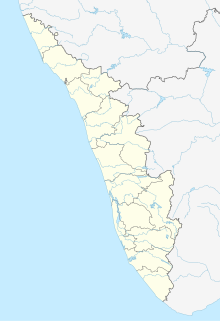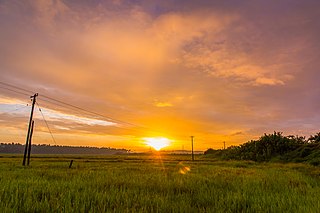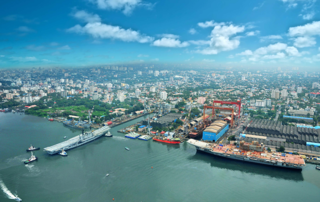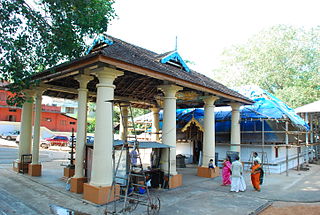
Thrissur, formerly Trichur, also known by its historical name Thrissivaperur, is a city and the headquarters of the Thrissur district in Kerala, India. It is the third largest urban agglomeration in Kerala after Kochi and Kozhikode, and the 21st largest in India. The city is built around a 65-acre (26 ha) hillock called the Thekkinkaadu Maidaanam which seats a large Hindu temple. It is located central of the state, and 304 kilometres (189 mi) north-west of the state's capital city, Thiruvananthapuram. Thrissur was once the capital of the Kingdom of Cochin, and was a point of contact for the Assyrians, Greeks, Persians, Arabs, Romans, Portuguese, Dutch and English.

The Thrissur Pooram is an annual temple festival held in Thrissur, Kerala, India. It is held at the Vadakkunnathan (Shiva) Temple in Thrissur every year on the Pooram day—the day when the moon rises with the Pooram star in the Malayalam Calendar month of Medam. It is the largest and most famous of all poorams in India.

Punkunnam is a commercial and residential area in Thrissur city of Kerala in India. It is 2 km away from the Swaraj Round. Punkunnam is the Ward 1 of Thrissur Municipal Corporation. Dr.V.Aathira (BJP) is the division councilor of Punkunnam. Punkunnam is home to the renowned Punkunnam Siva Temple. The Sitaram Textiles is situated here. It was established in Punkunnam by TR Ramachandra Iyer in the early 1940s. The spinning wing has the capacity of 12,000 spindles. The mill also has a capacity to process 40,000 meters of cloth every day. Poonkunnam Railway Station provides rail connectivity to other parts of Kerala and India. Punkunnam is witnessing a Real Estate boom as the number of High rise buildings are increasing on a fast pace here.

Patturaikkal is a commercial and residential area in Thrissur city of Kerala. It is only 2 km from. Poonkunnam Siva Temple and Thiruvambady Sree Krishna temples are located near Patturaikkal. Patturaikkal is Ward 2 of Thrissur Municipal Corporation.

Thrissur is a district of Kerala situated in the central part of that state. Spanning an area of about 3,032 km2 (1,171 sq mi), Thrissur district is home to over 9% of Kerala's population.

Ernakulam, is the central portion of the city of Kochi in Kerala, India and has lent its name to the Ernakulam district. Many major establishments, including the Kerala High Court, the office of the Kochi Municipal Corporation and the Cochin Shipyard are situated here. Ernakulam, which is where a huge part of the commercial activity in Kochi city happen, is known as the commercial capital of Kerala. The Ernakulam Junction is a major railway station of the Indian Railways, and the busiest railway station in Kochi city, the 2nd busiest in Thiruvananthapuram railway division and the 5th busiest in Southern Railways. Initially, Ernakulam was the headquarters of the Ernakulam District but was later shifted to Kakkanad, an eastern region in Kochi. Ernakulam was once the capital of the Kingdom of Cochin. It is located 220 kilometres (137 mi) north - west of the state capital Thiruvananthapuram. The city has served as an incubator for many Malayali entrepreneurs and is a major financial and commercial hub of Kerala. The Kochi Metro's first phase runs through Ernakulam region as well. The second phase aims to connect the CBD with the IT hub of Kakkanad.

Palarivattom (MRC) is a region in the city of Kochi in the state of Kerala, India. It is part of the District of Ernakulam. The region makes a four directional intersection at its highway signal point on the Kochi Bypass, which leads to 1) the Vyttila Junction in the South, 2) Kakkanad in its western direction, which is the IT hub of Kochi city, 3) the main junction of Edapally in its north end, which then diverges into the Northern and North-western regions of Kerala such as Kodangallur, Guruvayur, Thrissur, Calicut etc., and 4) eastward towards the central town area of Kochi. The junction is sometimes also referred as pipeline junction. Santhigiri Ashram Ernakulam Branch is in palarivattom.

Dravidian architecture or the South Indian temple style is an architectural idiom in Hindu temple architecture that emerged in the southern part of the Indian subcontinent or South India and in Sri Lanka, reaching its final form by the sixteenth century. It is seen in Hindu temples, and the most distinctive difference from north Indian styles is the use of a shorter and more pyramidal tower over the garbhagriha or sanctuary called a vimana, where the north has taller towers, usually bending inwards as they rise, called shikharas. However, for modern visitors to larger temples the dominating feature is the high gopura or gatehouse at the edge of the compound; large temples have several, dwarfing the vimana; these are a much more recent development. There are numerous other distinct features such as the dwarapalakas - twin guardians at the main entrance and the inner sanctum of the temple and goshtams - deities carved in niches on the outer side walls of the garbhagriha.

Punkunnam Shiva Temple, located in Punkunnam in Thrissur of Kerala. This temple is a classic example of the Kerala style of architecture. The main deity is Shiva. Parvathy, Ganapathy, Sastha, Nagaraja and Partha Sarathi are other sub deities(ഉപദേവത). The Ganeshotsavam is celebrating in grand style. During Sabarimala season the pilgrims are given food free of cost. Near to it is the Poonkunnam Seetha Ramaswamy Temple

Wadakkancherry is a major town in Thrissur, Kerala. Up until 1860, this area was part of Chelakkara Taluk. Now, it is the headquarters of Talappilly Taluk.
Devaswom are socio-religious trusts in India whose members are nominated by both government and community. They oversee Hindu temples and their assets to ensure their smooth operation in accordance with traditional rituals and customs. The devaswom system notably exists in the state of Kerala, where most temples are either managed by Government of Kerala-controlled devaswoms or formed by private bodies/families. The properties of each temple are deemed to be the personal property of the presiding deity of the temple and are managed through a body of trustees who bear allegiance to that deity.
Nalambalam is a set of four Hindu temples in Kerala. In Malayalam, Nalu means "four" and Ambalam means "temple". These are the temples for the Rama and his brothers of Ramayana. There are around five sets of Nalambalams in Kerala, the most famous among them being the four temples located in Thrissur and Ernakulam districts, namely Thriprayar Sree Rama Temple, Koodalmanikyam Bharatha Temple, Moozhikkulam Lakshmana Temple and Payyammal Shathrughna Temple.

Harinagar is a suburb of Thrissur town in Thrissur district, Kerala, south India. It is 3 km from the centre of the town. Harinagar housing colony is one of the largest colony in the town and the commercial and residential area of Poonkunnam. There are so many streets in this colony by which each house is known like Harinagar 4th street. Harinagar colony is surrounded by some of the famous Hindu Temples in the district like, Poonkunnam Siva Temple, Poonkunnam Seetha Ramaswamy Temple and Kuttankulangara Sri Krishna Temple.

Kuttankulangara Sri Krishna Temple located in Punkunnam, Thrissur district of Kerala, south India and is considered to be over a 300 years old. It is located in the Kuttankulangara ward of Thrissur Municipal Corporation. This temple is a classic example of the Kerala style of architecture. It is 500 m away from Punkunnam Railway station. It is believed that the god gives the fortune of progeny(സന്താനം). There is an interesting ritual called Pannivetta(പന്നി വേട്ട); model of pig is made and a hunter arrows it down at the base of the Banyan Tree (ആല്ത്തറ).
Punkunnam Seetha Ramaswamy Temple more commonly called as 'Pushpagiri Seeta Ramaswamy temple' is located in the Pushpagiri agraharam of Punkunnam, Thrissur City of Kerala, India.

Hinduism is the largest religion in Kerala and Hindu castes together make up 54.8% of the population of the state according to the 2011 census.
There are places of worship considered important in the Kannur district. Kannur District is one of the 14 districts in the state of Kerala, India. The town of Kannur is the district headquarters, and gives the district its name.

Kerala architecture is a kind of architectural style that is found mostly in the Indian state of Kerala. Kerala's style of architecture is a unique Hindu temple architecture that emerged in the southwest part of India, in its striking contrast to Dravidian architecture which is normally practised in other parts of South India. The architecture of Kerala has been performed/followed according to Indian Vedic architectural science and a part of the Dravidian architecture, one of the three styles of temples mentioned in the ancient books of Vastu Shastra. The Tantrasamuchaya, Thachu-Shastra, Manushyalaya-Chandrika, and Silparatna are important architectural sciences, which have had a strong impact on Kerala Architecture style. The Manushyalaya-Chandrika, a work devoted to domestic architecture is one such science that has its strong roots in Kerala.












